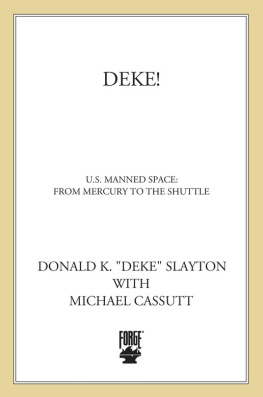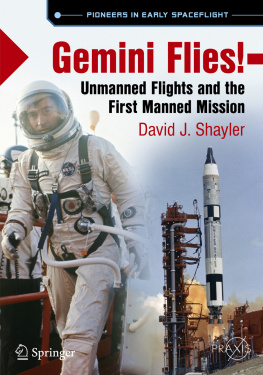Spaceshots and Snapshots of Projects Mercury and Gemini

Spaceshots & Snapshots of Projects
MERCURY
& GEMINI
A Rare Photographic History
JOHN BISNEY
J. L. PICKERING


ISBN for this digital edition: 978-0-8263-5263-7
2015 by the University of New Mexico Press
All rights reserved. Published 2015
Printed in Korea
20 19 18 17 16 2 3 4 5 6
The Library of Congress has cataloged the printed edition as follow:
Bisney, John, 1954
Spaceshots and snapshots of Projects Mercury and Gemini : a rare photographic history / by John Bisney and J. L. Pickering.
pages cm
Includes bibliographical references.
ISBN 978-0-8263-5261-3 (cloth : alk. paper)
1. Project Mercury (U.S.)History.
2. Project Gemini (U.S.)History.
3. AstronauticsUnited StatesPictorial works.
4. Space photographyUnited States.
I. Pickering, J. L., 1957
II. Title.
TL789.8.U6M425 2015
629.454dc23
2014024288
Cover photograph courtesy of NASA
Designed by Lila Sanchez
Contents
Foreword
Lt. Gen. Thomas P. Stafford, USAF (Ret.)
Gemini VI-A, Gemini IX, Apollo 10, Apollo-Soyuz Test Project
This book and Moonshots and Snapshots of Project Apollo (UNM Press, 2015) document a unique era, both in American history and in my life. The Space Race was the most visible of the Cold War competitions between the United States and the Soviet Union, and to the citizens of both countries, the most inspiring.
When I graduated from the United States Naval Academy in 1952, US forces were engaged in South Korea, fighting the North Koreans and the Chinese, with support from the Soviet Union. Twenty-three years later, I commanded the Apollo mission that docked with a Soviet spacecraft, symbolically bringing the Space Race to a close.
The most significant event in between, of course, was the 1969 Apollo 11 moon landing, the culmination of an enormous national effort to achieve President Kennedys goal and maintain our engineering and technology lead over the Soviets.
I was fortunate enough to fly on four of the thirty-one space missions documented in these books and was involved in most of the rest, so they are almost like yearbooks of my experiences with NASA. I hope you will both gain a greater understanding of the facilities and systems on the ground that we depended on, as well as the men and women who made it all possible.
The facilities we used during Gemini now seem somewhat spartan, but thats part of the texture this unique book provides. It gives a good sense of what it was like to spend many days at Cape Canaveral or in Houston; and when you werent at either place, you were aboard an aircraft, spacecraft, or naval vessel!
I was privileged to be one of twenty-two Apollo astronauts to visit the moon. Looking through those chapters, Im still struck by the size and scale of the program, from the Vehicle Assembly Building and the Saturn V to the massive network of contractors across the country that built it all and the worldwide coordination and cooperation it required.
Our in-flight photography shows the true beauty of the earth and moon from space, something we never got tired of enjoying. I remember commenting during Apollo-Soyuz Test Project (ASTP) that because our Earth orbital altitude was about forty miles lower than during my Gemini flights, it was possible to see far more detail on the ground.
I had not seen many of the photos in these books before or heard some of the stories, so I appreciate the efforts of the authors, whom I have known for many years. Their research into the NASA repositories and other sources takes you behind the scenes and gives you a better appreciation for the enormous size of the undertaking.
Im especially grateful for the recognition given to all the men and women on the ground who were responsible for our successes and learned from our failures. In these pages, youll meet some of the most talented and dedicated people I have ever known; a few I had long forgotten, but most I will never forget.
Finally, it brought back many memories of the can do attitude we once had in our space program and the fun we often had along the way. I look at these photos and ask myself, Who are those young guys and what were they thinking? At the time, I knew on some level it was the greatest adventure in the history of humanity. To this day, I believe it still is and will be until we send astronauts beyond the moon and into the solar system. Until then, we can only imagine those snapshots.
Preface
John Bisney
Bethesda, Maryland
J. L. Pickering and I have been space-flight enthusiasts since we were elementary school baby boomers thrilled by the Mercury astronauts as they took on the Soviet Unions cosmonauts in the space battles of the Cold Wars Space Race. We made our parents take us to the Johnson Space Center (J. L.) or the Kennedy Space Center (me) as kids, and we both wrote to NASA asking for photos and information.
In the intervening years, our interest in and love for this era only deepened. J. L. turned his boyhood hobby into a lifelong passion, accumulating what is possibly the largest private library of high-quality photos of the early US manned space program. He assembled this collection, numbering well over one hundred thousand high-quality images (and growing), over more than forty years from public and private sources, including through unprecedented access to NASA photo archives thanks to certain understanding public affairs staff. Other great sources included fellow collectors, retired NASA and news photographers, auction houses, and even eBay.
Today, he is often contacted by authors, historians, astronauts, and even NASA as the go-to source for hard-to-find images, and his website, retrospaceimages.com, offers compilations of rare high-resolution photos from each flight well into the Space Shuttle program.
My family moved to St. Petersburg, Florida, in 1965, and I saw my first rocket launch the following year from Cocoa Beach. Using connections through a local science education center, I attended most of the manned Apollo launches, including meeting President Nixon at Apollo 12. In 1975 J. L. and I were both at the Kennedy Space Center (KSC) Press Site for the ASTP launch. He was there stringing for his hometown newspaper and I was covering it for my college radio station, but we never met.
I became a national radio correspondent based in Washington, D.C., and was assigned to cover the space program from 1981 to 2011. J. L. and I finally connected in 1986 through exchanging letters as fellow collectors of insider space memorabilia and quickly became good friends.
During the 1980s and 90s, we frequently traveled to Cocoa Beach and Houston to meet and visit with the men and women, usually retired, who were the heart and soul of our early manned space program, often timing our Florida trips around my shuttle coverage. We became especially close with Paul C. Donnelly (whom you will meet), the former KSC launch operations manager and a true pioneer who died in 2014 at age ninety.
We didnt realize it at the time, but our vacations were steadily laying the groundwork for this and
Next page







